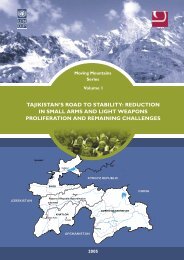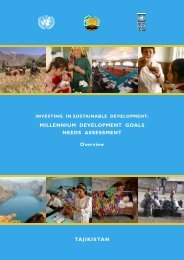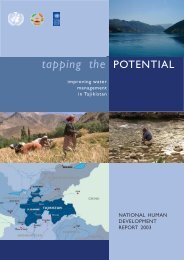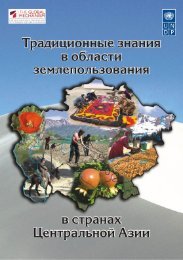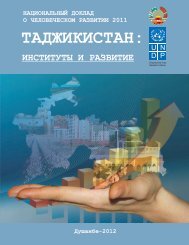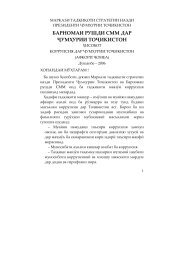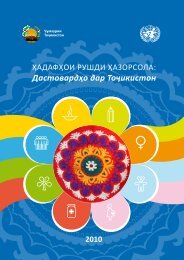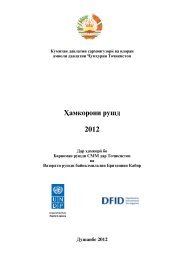Eng - UNDP in Tajikistan
Eng - UNDP in Tajikistan
Eng - UNDP in Tajikistan
Create successful ePaper yourself
Turn your PDF publications into a flip-book with our unique Google optimized e-Paper software.
DEVELOPMENT PARTNER PROFILE<br />
Multilateral<br />
United Nations High Commissioner for Refugees<br />
Contact: Mr. Iliya Todorovich<br />
UNHCR Representative<br />
Tel: 221-83-78, 221-82-46, 221-74-24 Fax: 251-00-39<br />
E-mail: TJKDU@UNHCR.ORG<br />
Website:<br />
Organization Profile<br />
The United Nations mandates UNHCR, the United Nations refugee organization, to lead and coord<strong>in</strong>ate <strong>in</strong>ternational action for the world<br />
wide protection of refugees and the resolution of refugee problems. UNHCR's primary purpose is to safeguard the rights and well be<strong>in</strong>g of<br />
refugees. UNHCR strives to ensure that everyone can exercise the right to seek asylum and f<strong>in</strong>d safe refuge <strong>in</strong> another state, and to return<br />
home voluntarily. By assist<strong>in</strong>g refugees to return to their own country or to settle <strong>in</strong> another country, UNHCR also seeks durable solution to<br />
their plight. UNHCR's efforts are mandated by the organization's Statute and guided by the 1951 UN Convention relat<strong>in</strong>g to the Status of<br />
Refugees and its 1967 protocol. International Refugee Law provides an essential framework of pr<strong>in</strong>cipals for UNHCR's humanitarian<br />
activities. UNHCR actively seeks to consolidate the re<strong>in</strong>tegration of return<strong>in</strong>g refugees to their country of orig<strong>in</strong>, thereby avert<strong>in</strong>g the<br />
recurrence of refugee-produc<strong>in</strong>g situations. UNHCR offers protection and assistance to refugees and other persons of concern to UNHCR, on<br />
the basis of their need and irrespective of their race, religion, political op<strong>in</strong>ion or gender. UNHCR pays particular attention to the need of<br />
children and seeks to promote the equal rights of women and girls. In its efforts to protect refugees and promote solution to their problems,<br />
UNHCR works <strong>in</strong> partnership with government, <strong>in</strong>ternational and non-governmental organizations. UNHCR provides protection and<br />
assistance not only to refugees, but also to other categories of displaced or needy persons. These <strong>in</strong>clude asylum seekers, refugees who have<br />
returned home but still need help <strong>in</strong> rebuild<strong>in</strong>g their lives, local civilian communities which are directly affected by the movements of<br />
refugees and, perhaps most importantly grow<strong>in</strong>g numbers of <strong>in</strong>ternally displaced persons (IDPs). UNHCR has been work<strong>in</strong>g closely with the<br />
Government on capacity build<strong>in</strong>g through tra<strong>in</strong><strong>in</strong>g of judges, lawyers and law enforcement bodies, provid<strong>in</strong>g technical assistance towards<br />
draft<strong>in</strong>g legal <strong>in</strong>struments meet<strong>in</strong>g <strong>in</strong>ternational standards. In addition to their legal vulnerability, refugees are highly dependent on UNHCR<br />
material assistance. UNHCR protection and material assistance serves as a mean of survival for many of them.<br />
Past and Current Programmes<br />
In 1993 UNHCR started the repatriation, rehabilitation, reconstruction and re<strong>in</strong>tegration program for Tajik returnees. Dur<strong>in</strong>g this period more<br />
than 53,000 Tajiks were repatriated from Afghanistan, Pakistan, Turkmenistan, Kyrgyzstan, Uzbekistan and Kazakhstan. In order to raise the<br />
absorption capacity <strong>in</strong> area of return, rehabilitation of <strong>in</strong>frastructure was undertaken and follow<strong>in</strong>g work has been successfully completed:<br />
25,000 destroyed houses, 9 schools and 11 health cl<strong>in</strong>ics reconstructed; 4 water supply system rehabilitated and 3, 048 hand pumps <strong>in</strong>stalled<br />
<strong>in</strong> Khatlon region. Besides UNHCR funded agriculture projects such as: reconstruction of 23 irrigation pumps, development of land lease<br />
(2,204 ha), canal dra<strong>in</strong>age clean<strong>in</strong>g (26,772 km), distribution of seeds and fertilizers, construction of 22 rice and flour mills, 1,585 livestock<br />
distributed, veter<strong>in</strong>arian service.<br />
In 2001, UNHCR established micro-credits projects for return<strong>in</strong>g Tajiks. These projects also benefited other member of the community,<br />
namely, those Tajiks that did not flee their country because of the conflict. The projects have been very successful with a 99% reimbursement<br />
rate. In 2006, UNHCR decided that it was time to place them under a development strategy and, on 20 December 2006, signed a<br />
Memorandum of Understand<strong>in</strong>g with the United Nations Development Program (<strong>UNDP</strong>), for their transfer, effective 1 January 2007, to that<br />
United Nations agency.<br />
UNHCR has been work<strong>in</strong>g closely with the relevant authorities of <strong>Tajikistan</strong> and, <strong>in</strong> particular, with the State Agency on Social protection,<br />
Employment and Migration to br<strong>in</strong>g the national Refugee Status Determ<strong>in</strong>ation (RSD) procedure <strong>in</strong> l<strong>in</strong>e with <strong>in</strong>ternational standards. UNHCR<br />
has been provid<strong>in</strong>g assistance to tra<strong>in</strong> Government Officials and strengthen <strong>in</strong>stitutions deal<strong>in</strong>g with refugees.<br />
UNHCR has been facilitat<strong>in</strong>g the voluntary return of Afghan refugees to their country. S<strong>in</strong>ce 2002, some 10,000 Afghan refugees have<br />
returned to their country with UNHCR's assistance. The numbers are decreas<strong>in</strong>g, however, as witnessed by the fact that <strong>in</strong> 2004 there were<br />
only 66 returns, 25 <strong>in</strong> 2005, 52 <strong>in</strong> 2006 and 27 <strong>in</strong> 2007.<br />
In 2004, UNHCR and Canada agreed to implement a resettlement program for refugees <strong>in</strong> <strong>Tajikistan</strong>. A similar agreement was reached with<br />
the United States and a program started <strong>in</strong> 2005. Both programs came to an end <strong>in</strong> late 2006. Under these resettlement programmes, over<br />
1,300 refugess, ma<strong>in</strong>ly Afghans, were resettled to Canada and USA.<br />
The current UNHCR objective is to build asylum regime <strong>in</strong> the country, f<strong>in</strong>d durable solutions to long-stay<strong>in</strong>g Afghan refugee <strong>in</strong> the country,<br />
cont<strong>in</strong>ue to provide legal assistance to asylum seekers and refugees and material assistance to the neediest refugees.<br />
Future Programm<strong>in</strong>g Direction<br />
In 2008, UNHCR will pursue the follow<strong>in</strong>g ma<strong>in</strong> objectives. First will provide technical and legal advice and assist Government and<br />
<strong>in</strong>stitutions deal<strong>in</strong>g with refugees and asylum seekers to fulfil the obligations under 1951 Convention relat<strong>in</strong>g to the status of refugees and its<br />
1967 Protocol, to ensure that the laws of the Republic of <strong>Tajikistan</strong> are consistent with <strong>in</strong>ternational legislation and practice.<br />
Second, UNHCR will cont<strong>in</strong>ue to seek durable solutions for Afghan refugees. In this respect, the voluntary repatriation <strong>in</strong> <strong>Tajikistan</strong> will<br />
cont<strong>in</strong>ue as <strong>in</strong> previous years. Resettlement will be pursued for vulnerable and deserv<strong>in</strong>g cases on an <strong>in</strong>dividual basis. Resettlement to third<br />
countries will be carried out on an <strong>in</strong>dividual basis as a protection tool and for cases of family reunification.<br />
Third, seek and implement solutions for rema<strong>in</strong><strong>in</strong>g long-stay<strong>in</strong>g Afghan refugees, namely those who cannot or do not want to return to their<br />
country of orig<strong>in</strong> and do not meet resettlement criteria. F<strong>in</strong>d<strong>in</strong>g local solutions for rema<strong>in</strong><strong>in</strong>g Afghan refugees <strong>in</strong> <strong>Tajikistan</strong> has been discussed<br />
Source: Aid Coord<strong>in</strong>ation and Project Monitor<strong>in</strong>g System Database<br />
© State Committee on Investments and State Property Management of the RT<br />
112




